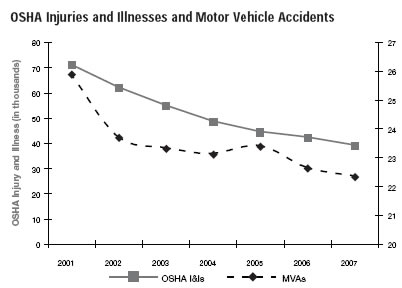Chapter 3 Our Workforce
Workplace Environment
SAFETY
The Postal Service made continued safety improvements in 2007. National safety indicators and accident reduction plans targeted the most serious and prevalent accidents (including motor vehicle accidents) and illnesses. Employee-awareness efforts on avoiding injury and illness included safety talks, internal publications, and videos, including the award-winning Safety Depends on Me video campaign. The Occupational Safety and Health Administration’s (OSHA) 2007 injury and illness frequency rate for the Postal Service was 5.51 per 100 employees. This is a 4.7 percent improvement from 2006, and equates to 39,159 OSHA injuries and illnesses.
Since 2001, the Postal Service has reduced the total number of OSHA injuries and illnesses by 31,680, a 44.7 percent reduction. The motor vehicle accident frequency rate was 9.79 per million miles, down 1.21 percent from last year. Since 2001, the Postal Service has reduced its total number of motor vehicle accidents by 3,537, a 13.7 percent reduction.
Voluntary Protection Programs
The Postal Service continues to collaborate with the OSHA to implement the Voluntary Protection Program (VPP). VPP recognizes excellence in safety and health protection and is implemented through joint labor-management safety committees. To qualify for VPP certification, a facility must have comprehensive safety management systems, and employees must be actively involved in anticipating, evaluating, and controlling potential hazards. OSHA recognizes only those facilities that have implemented the best programs. OSHA has recommended or approved a total of 133 postal worksites for VPP participation. In 2007, 37 sites achieved VPP status, including 34 that reached Star status, the premier OSHA designation. On average, VPP sites post OSHA injury and illness reductions that are 11 percent better than non-VPP sites.
Ergonomic Risk Reduction Process
The Ergonomic Risk Reduction Process (ERRP) reduces both the number and severity of musculoskeletal disorders, builds labor/management teams with ergonomic skill, and cultivates partnerships to identify and control ergonomic risk. These partnerships are cultivated among the Postal Service, OSHA, the National Postal Mail Handlers Union, and the American Postal Workers Union. To date, 157 sites have implemented ERRP (151 plants and 6 districts) and over 122,000 employees have received ERRP training. ERRP teams have analyzed and resolved 9,805 tasks, and implemented 6,783 employee-submitted solutions. Some of the most successful solutions reduce handling and lifting injuries.

Customer Service employees have also requested an ergonomic process to help identify and reduce musculoskeletal disorders. The organization of ERRP for Customer Service (CS ERRP) differs from the plants since CS ERRP is not confined to a single building. The Sacramento and Portland Districts implemented CS ERRP in 2007 after additional refinements were made.
EQUAL EMPLOYMENT OPPORTUNITY
The Equal Employment Opportunity (EEO) function is organized into two components: the National Office of EEO Compliance and Appeals Programs, which handles EEO policy and informal complaint processing, and the National EEO Investigative Services Office (NEEOISO), which oversees the formal EEO complaint process. The separation of the informal and formal processes allows each group to concentrate efforts and apply the most appropriate tools.
The National EEO Compliance and Appeals field offices reorganized into a regional structure in 2007. The four EEO Regions are designed to make efficient use of EEO personnel. This structure also allows for a more proactive approach to complaint reduction. The four EEO regional managers oversee the field offices. Field offices handle the informal complaint process including EEO counseling and alternative dispute resolution programs such as the Resolve Employment Disputes Reach Equitable Solutions Swiftly (REDRESS) mediation program. Throughout the year, training was held for supervisors and managers on the importance of equal employment opportunity, open communication, and the benefits of resolving complaints at the lowest possible level. In 2007, employees elected for mediation in 82 percent of eligible cases; 75 percent of those complaints were resolved. This year, 17,460 informal complaints were processed, with 98 percent of them closed within regulatory timeframes.
The Postal Service’s goal is to produce high quality and timely complaint processing in accordance with EEOC regulations. NEEOISO completed 96.1 percent of all investigations within the 180-day timeframe, reduced the average time to issue a merit decision to 23 days, and processed 37,742 requests for EEO counseling. NEEOISO completed 98 percent of Final Agency Decisions within 35 days from receipt. The Notice of Final Action process was completed within 25 days of receipt 95.2 percent of the time. Letters of Acceptance or Dismissal were mailed 98 percent of the time within the 35-day time allowance. Contract investigators and final agency decision writers were used to help maintain the neutrality of the investigative and decision process.
NEEOISO has consistently attained high scores in the completion of EEO cases, and is now providing services to nine other federal agencies on a fee-for-service basis. NEEOISO has been recognized by the EEOC for achieving the highest timeliness rate for the completion of Final Agency Decisions among the Federal Sector Agencies.